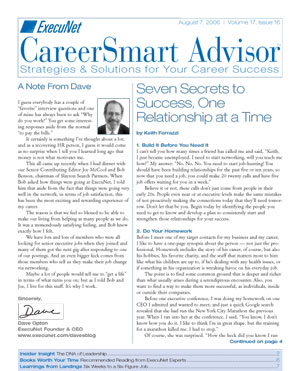By Judith E. Glaser | Execunet Magazine
Published: August, 2006
 All human beings have a DNA for Leadership made up of Seven Vital Genes — which contain the encoded messaging for how to lead in a world where collaboration and interdependence is the formula for success. Once leaders understand the wisdom of leadership, and the conditions under which the leadership genes become expressed or suppressed, they are able to crack the code on leadership and culture change.
All human beings have a DNA for Leadership made up of Seven Vital Genes — which contain the encoded messaging for how to lead in a world where collaboration and interdependence is the formula for success. Once leaders understand the wisdom of leadership, and the conditions under which the leadership genes become expressed or suppressed, they are able to crack the code on leadership and culture change.
Genetic Research
Unlike conventional wisdom that says our DNA does not change, new research has identified two different types of DNA: that which does not change — our identity genes — and that which changes — our regulatory genes, which can be influenced by the environment and by interaction with others. Language influences how we feel and how we interact with each other — hence conversations regulate change.
This is a breakthrough concept. Once leaders understand the regulatory nature of conversations, they are able to facilitate growth and development inside of people, teams and organizations. In other words, they are able to facilitate change.
In the Beginning
Perhaps you’ve heard the story about the leader who, when faced with a crisis of momentous proportion, went alone to a mountain retreat to meditate and seek inspiration. He sweated over which option he would choose that would determine the future of his team: continue to battle the forces that threatened their survival, likely at great cost, or cut their losses and move on in search of a new way.
After tortured contemplation, this great leader decided to accept a new approach, and that changed everything about his culture and ensured its longterm survival. He turned to his organization and shared his ideas with them. Together they worked on how to transform the culture. Rather than feeling he needed to hold the challenge inside, he engaged with his people to create change.
Could this be about a CEO of a Fortune 100 company, or about a valiant entrepreneur at a high-tech startup? If it sounds familiar, it is the story of Moses, and it reminds us that the challenges we face as leaders are as old as recorded history and remain the same.
We are individuals finding our way in the world, finding our purpose, and joining together with others to create something great. Whether we lived in ancient times or today, our vital instincts are the same. Human beings need to bond to live; and once we realize the power of connectivity, we will see how to facilitate it or erode it.
An organization’s ability to get to its next level of greatness is determined by the climate of the culture, which is determined by the quality of the relationships which is determined by the quality of the conversations.
Everything happens through conversations.
The wisdom of the ages is available — and eminently useful — to all of us now. But it doesn’t take divine intervention to lead boldly and effectively in the face of challenges. What it takes is the awareness that to master change you must first understand how people change, and that requires a willingness and courage to be open to learn from the wisdom embodied in our leadership DNA.
Why do some companies thrive in both bull and bear markets, while others seem constantly beset by organizational and financial setbacks? It has to do with the way leadership DNA is expressed. Our genetic code is encoded for I-thinking and for WE-thinking. Those leaders who are masters at creating experiences that communicate “We’re all in this together” bring out the best in all of us, and rally us to achieve great heights even in fact of incredible challenges.
The Buck Stops Here!
The remarkable success of Starbucks, which went from less than 100 locations to over 8,000 in 15 years, is not just because of a great product and a good business plan. It’s because they see every employee as a partner who delivers an “experience” to millions of customers, one at a time.
Companies like Starbucks and the others we have researched, worked with and profiled are led by executives who consistently express the WE half of our genetic code to positively impact their leadership teams and employees. They understand that success, despite capital and technology, comes down to how people work together to creatively shape the future. They know that what they say and do shapes their environments, and that environments are their brands. They know that the “I” alone is not what leadership is about; it’s the “I inside the WE” that needs to come alive.
Evolution and growth take place in healthy cultures that handle conflict and change effectively. This is best done when the thinking and the energy that solutions require come from the collective whole instead of from one person or a small group. I-centric leaders dictate and imitate, and their organizations are stagnant when confronted by change. WE-centric leaders integrate, differentiate and innovate, and their organizations capitalize on change and constantly move forward.
In healthy organizations the “I” can differentiate its uniqueness inside of the “WE” — one of the most powerful concepts of the 21st century leadership. Our Leadership DNA is encoded to teach us how to bond with others inside and outside of our organization, so that the “I” transforms into a healthy “WE.”
Each gene in our DNA helps us examine leadership from the words (micro) to the behaviors and practices (macro) that combine to create a growth environment. Compelling use of our leadership genes reshapes our organization from a territorial one to a community that gels with a shared view — not because of forced compliance, but because of a genuine commitment to common and far-reaching goals.
Forward-thinking leaders are not limited by narrow thinking. They challenge old ways and upset the status quo if it stands in the way of progress. Most of all, they are driven by an overriding purpose: to release the unbounded potential of WE.
Connections throughout the Organization
In today’s increasingly connected world, companies themselves must also be finely interwoven to connect effectively with their suppliers, partners and customers. How you link your employees to one another, and to other teams and divisions, makes all the difference in how successfully you connect to your outside world to achieve your mutual success.
Do you withhold information, enforce boundaries and defend territory, or do you cross boundaries to share knowledge, decision-making power, and ownership of ideas and success? Do you rely solely on your own knowledge and vast experience, or do you tap into the wealth of resources readily available in your team and across your company? Understanding how to foster connections lightens everyone’s load and leads to greater success faster.
Corresponding Corporate Culture
How you express your Leadership DNA determines the norms and patterns that govern how everyone works together — “the way it is around here.” Culture represents how work gets done, from how you make decisions, to how you run meetings, to how you assign projects, to how you recognize and reward effort, to how you develop employees. These patterns stamp everything and ultimately define your brand.
Do you hold people back or challenge them to advance to the next level of skill and responsibility? Are you distant and secretive, or accessible and open? Is your vision created and implemented by a select few, or does everyone contribute to its definition and realization? Leaders, who practice rituals that maintain stability while at the same time embrace change and encourage personal growth, will be the most successful in the new millennium.
| Leadership Gene | Pair Bond | Progress Culture |
|---|---|---|
| C: Community | Including vs. Excluding | Instead of bonding with others through dictatorship, create environments with open and transparent communication where people feel included, involved in the strategy, engaged in the business, and accountable for results. |
| H: Humanity | Appreciating vs. Blaming | Instead of bonding with others through judgment and retribution, create an appreciative atmosphere that values uniqueness and diversity, and respects the talents of each individual. |
| A: Aspiration | Striving vs. Fearing | Instead of bonding with others through overt and covert threats to meet targets, marshal the wonder of individual imagination and desire to achieve greatness. |
| N: Navigation | Sharing vs. Withholding | Instead of bonding with others by withholding power and resources, ask others within teams and across the division for guidance in making headway toward common goals. |
| G: Generativity | Wondering vs. Knowing | Instead of bonding with others through micromanaging and enforcing compliance with what has always been, nurture innovation that leads to inspired breakthroughs. |
| E: Expressing | Developing vs. Dictating | Instead of bonding with others by stifling voices in favor of one voice, encourage all to speak up, take risks, and develop themselves to develop the organization. |
| S: Spirit | Celebrating vs. Conforming | Instead of bonding with others through cold calculations and expectations, create an atmosphere of ongoing homage, accomplishment and evolution, so that everyone pulls together to move toward the future. |
How to Encode and Decode the Genes
Leaders influence the culture of an organization. We’ve identified a set of dimensions that, we believe, dramatically influence how leadership is expressed in organizations. When you focus your attention on these dimensions, you create environments where the human spirit can thrive in the face of internal and marketplace challenges.
Leading with these dimensions in mind, you are able to reduce fear, increase trust and support, and unleash the maximum potential of every individual and the collective whole. Each dimension — or “gene” — is used to activate leadership for effective solutions, development and growth.
Genetic research conducted by scientists such as Dr. Kathleen Hall and David Haig is beginning to validate the fact that our genes are encoded to be impacted by the environment — and they have a survival and vital nature. Depending on the “feel” of the environment either the survival or vital side of the gene is triggered. Based on this emerging proposition, we are proposing that if we understand the nature our genetic code, we can shape environments to express our vital leadership dimensions.
The Seven Vital Leadership Genes: C-H-A-N-G-E-S
Like our cellular DNA, these leadership practices always bond together in pairs. The seven “pair bonds” determine the culture of your organization, how it responds to the constant change associated with personnel, products, vendors, partners and customers.
Each half of the practice pairs will either lead to growth — capitalizing on change — or stagnation — resistance to change. When leaders are mindful of the power of these genes, and the positive effect the progressive half of the pair bond has, they will sustain and develop their organizations in the face of business challenges.
Within each pair are insights into how to shape practices and when they are “grafted” into meetings, conversations, new product development, and strategic business transformations such as mergers and acquisitions, they will enable you to successfully manage change — instead of change managing you!








